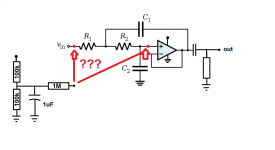Hello! I was wondering if a high-Z-in unity gain buffer and a second order low-pass filter could be combined, so that when just one op-amp is used less noise is introduced? I intend to use a single supply, so the ground point is virtual via a resistor divider. If I want to use the second order filter with a single supply how should I bias it ? Is it possible that the high input impedance is preserved? To which point in the attached schematic should I connect the bias resistor? Will it interfere with the filter and can this interference be accounted for?
Attachments
The filter will not have a high input impedance, and it will vary with frequency, although it will depend on component values. If you use high values, then you will get more Johnson noise. It depends on your application.
The bias is best applied at the input, and in many cases may be able to be taken directly from the previous stage. Applying bias straight to the opamp input pin will affect the filter operation, although by how much depends on component values.
Modern opamps are not very noisy. Saving an opamp, but therefore having to use higher value resistors, may give you more noise.
The bias is best applied at the input, and in many cases may be able to be taken directly from the previous stage. Applying bias straight to the opamp input pin will affect the filter operation, although by how much depends on component values.
Modern opamps are not very noisy. Saving an opamp, but therefore having to use higher value resistors, may give you more noise.
No, not in the passband. Think about it: at low frequencies the capacitors can be ignored so the filter becomes a unity-gain buffer with a few unnecessary resistors in front. At higher frequencies it will add some phase shift - up to 180 degrees in the stop-band.
There is plenty on the web about this. Just google Sallen-Key filter.
There is plenty on the web about this. Just google Sallen-Key filter.
- Status
- Not open for further replies.
